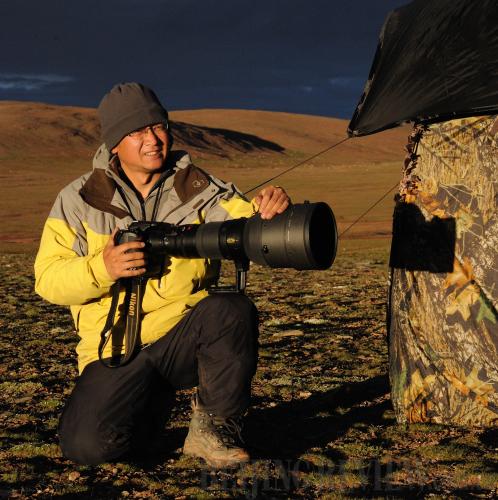|
 |
|
Pei Jingde in Hoh Xil in 2009, where he captured a scene of a Tibetan antelope giving birth (COURTESY OF PEI JINGDE) |
As an environmental protection volunteer and a member of China Photographers Association, Pei Jingde started taking pictures of various wild animals and recording ecological changes in the Hoh Xil area of northwest China since 2005. His works have won prizes at many photography exhibitions at home and abroad. In 2009, Pei was nominated for Green China Person of the Year to honor his outstanding contributions to environmental protection initiatives.
First glimpse
"I had longed to visit Hoh Xil, to imagine its legends and experience its mysteries," said Pei. "My dream came true in September 2005, when I was allowed, as a volunteer, to join a scientific expedition with experts from the Chinese Academy of Sciences and colleagues from the media."
Pei shot many photos during the 40-day journey across Tibet Autonomous Region, Xinjiang Uygur Autonomous Region and Qinghai Province.
Hol Xil is an 83,000 square km region shared between Qinghai, Tibet and Xinjiang. It includes the Qiangtang area in Tibet, Altun Mountains in Xinjiang and Qinghai Province's Sanjiangyuan, from which flows China's three major rivers: the Yangtze, Yellow and Lancang. Most of the area remains original intact and undamaged by human activity and is rich with ecological wealth of priceless value to humanity.
The Hoh Xil Nature Reserve, covering an area of 45,000 square km, is one of the world's best protected ecosystems, and also one of China's largest nature reserves at the highest altitude with the most wild animals. Due to the unforgiving climate and inhospitable natural conditions, the area is known as a "no man's land."
"For the first time, I saw glaciers, snow-capped mountains and wild animals such as Tibetan antelopes, brown bears and Tibetan wild donkeys when I arrived at Hoh Xil," said Pei. "I was afraid of disturbing their quiet and graceful lives when I focused my lens on the wild animals."
Pictures and videos will help people to know the significance of environmental protection of this area, said Pei. "However, it will take years to really capture ecosystems, wild species, regional customs, as well as relations between people and Hoh Xil," said Pei.
Photographic experiences
Over six years, he had spent about 300 days shooting wildlife in Hoh Xil. He now is able to provide a great deal of pictures and notes about Hoh Xil, opening windows into the mystical area.
By the end of 2006, he returned alone to do photography in the area again, without vehicles or sponsors. It was a rigorous test for him physically and spiritually.
"To get pictures of animals' activities in early morning, I set out on foot at 3 a.m. But when I arrived at the venue where I would take pictures, animals were already there before me," Pei said with a smile.
Pei would take pictures in the bone-chillingly cold wind of December on the Qinghai-Tibet Plateau. "Local workers in the nature reserve offered to help with my photography after they found out that my aim was to help improve protection of the local ecological resources and animals," he told Beijing Review.
One day in July 2007, Pei and another journalist were on the way to Chonai Lake in Hoh Xil to take pictures of antelopes giving birth, when Pei's counterpart was struck with a serious case of altitude sickness and they were forced to stop. According to local warnings, any setbacks preventing them from arriving at their destination safely and swiftly could prove deadly for Pei's companion. For the safety of the journalist, therefore, they had to return the same way they had arrived.
However, they didn't expect road would be so difficult to backtrack. The hardship was beyond their imagination. As the climate became warmer, the soil in the area softened to mud. Their vehicle became trapped 80 km away from Qinghai-Tibet highway. "We had to find stones to fill up the wheels and we dug out mud for 2,000 meters with our hands until we found frozen earth," Pei recalled. "Our hands bled."
Pei had gone four hard days in Hoh Xil without food or hot water. He later learned that his wife even thought he had died. "In the night it was extremely cold, so we had to embrace one another to conserve heat," he said.
In 2009, Pei captured a scene of a Tibetan antelope giving birth. "I believe that I will be the world's first to shoot such a scene," Pei exclaimed.
"I was happy during every day of shooting in Hoh Xil – although sometimes I encountered dangers – because it is of a significant work, which is hard for me to give up," Pei said.
Promoting environmental protection
In spite of greater efforts to protect Hoh Xil Nature Reserve by the state, poaching still occurs occasionally, demonstrating the importance of publicizing wildlife protection in Tibet.
Pei has made exquisite Tibetan calendars using his photos. He offered these calendars to local Tibetan Buddhist monks, and asked them to send these presents to local people during Tibetan New Year and other gatherings and celebrations.
The death of eco-defender Sonam Dhargye in a battle against antelope poachers in 1994 gave Pei greater motivation to promote environmental protection.
Pei found that Sonam's tomb was damaged and would collapse in a few years. He decided to try to cooperate with the local government to rebuild the monument, with an aim to remind people that protecting environment is to protect the future of humanity.
Pei plans to introduce the true Hoh Xil to audiences through his photo exhibitions, and will publish a series of records of the ecology of Hoh Xil.
"The longer you shoot the area's ecological and environmental changes, the better," said Pei. "How much better it would be if I was able to continue this work for another 50 years or longer," said Pei. | 